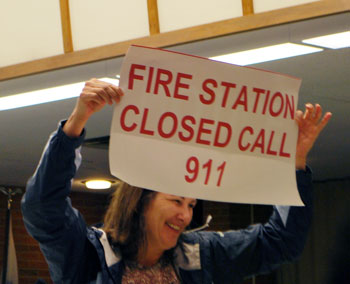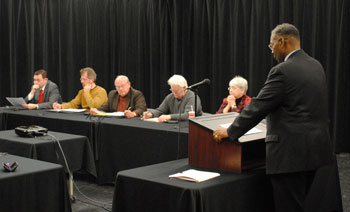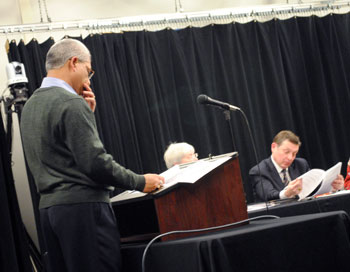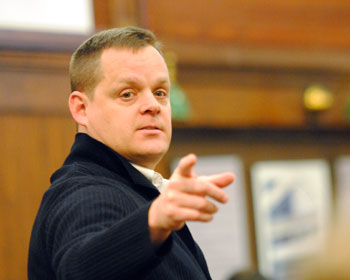Ann Arbor Council Delays Budget Vote
Ann Arbor city council meeting (May 16, 2011): Ann Arbor’s city charter requires that the city council amend and adopt a city budget by its second meeting in May. If it fails to act, by default the unamended budget proposed in April by the city administrator is adopted.

During public commentary, Sue Maguire addressed the council on the topic of proposed reductions to the fire department. (Photos by the writer.)
But Monday, at its second meeting in May this year, the city council did not act, choosing instead to recess and continue the meeting the following week, on May 23. The decision to delay was prompted by uncertainty about revenue from the public parking system. The Ann Arbor Downtown Development Authority and the city were poised to ratify a new agreement on parking revenue on May 2, but that agreement was put off when questions were raised about the DDA tax increment finance (TIF) capture. The DDA later called a special meeting on Friday, May 20 to address that issue.
Even though the council did not act on the budget, most of the evening’s discussion was dominated by budget talk, including extensive public commentary on the proposed cuts in the police and fire departments. The council also got a briefing from its chief of police and interim fire chief, Barnett Jones, who responded to an article published in AnnArbor.com about fire department response times, calling the calculations presented in the piece inaccurate.
In addition to putting off action on the FY 2012 budget, the council also tabled decisions on human services funding, funding for a water system study, and fee increases for next year.
However, the council did transact some business. It authorized an increase in taxicab fares in light of rising gas prices. The council also approved neighborhood stabilization funds for demolition of three houses on North Main Street to prepare the site for construction of the Near North affordable housing project. Two large vehicle purchases – a street sweeper and a sewer truck – that had been postponed from the previous meeting were authorized.
The council also revised its administrative policy on how the 2006 parks millage is to be spent. Funds outside the general fund can count as general fund money for the purpose of the policy, as long as those funds are not drawn from the parks millage. The council also gave initial approval to an ordinance on design guidelines for new buildings downtown. [Full Story]







